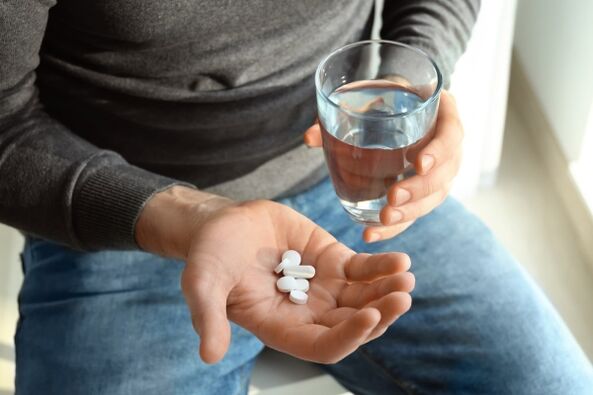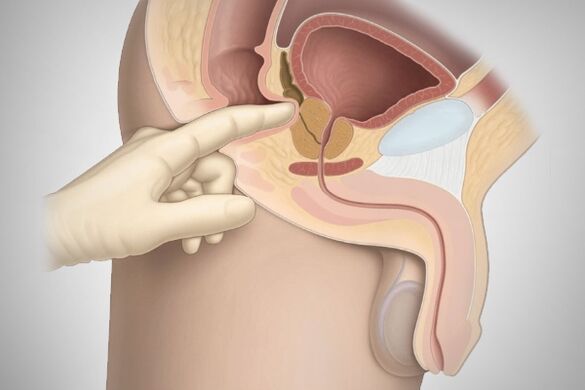Sometimes men face such an unpleasant disease as bacterial prostatitis. To initiate treatment promptly, it is important to know what signs of the disease can be identified, and what diagnosis and therapy will be needed.
Bacterial prostatitis is an infectious disease of the prostate gland. Symptoms of the disease include pain in the perineum, increased body temperature, intoxication, and other signs. Such a condition may require urgent hospitalization, as it can threaten the patient's health and life.
Types of bacterial prostatitis
Depending on the course and manifestations of the symptoms, bacterial prostatitis is divided into two forms - acute and chronic.
Sharp
The acute form presents suddenly and is accompanied by various unpleasant symptoms. The acute form of bacterial prostatitis requires immediate medical attention. This pathological process is caused by Escherichia coli, staphylococci, enterobacteria.
Acute prostatitis can be easily diagnosed using laboratory tests. Severe symptoms and clinical picture allow for an accurate diagnosis. Treatment of this form of prostatitis is complex using drugs and physiotherapy.
Chronic
Chronic prostatitis caused by pathogenic bacteria can be identified using laboratory tests and studies. The main pathogens are gonococci, chlamydia, ureaplasma, mycoplasma. The inflammatory process can also be caused by tuberculosis bacteria or fungi of the genus Candida, if the man is infected with HIV.
Types of bacterial prostatitis
Bacterial prostatitis is classified according to the type of pathogen:
- tuberculosis (Koch bacillus);
- gonorrheal (gonococci);
- mushrooms (types of mushrooms);
- chlamydia (chlamydia);
- viruses (the causative agent of herpes, human papillomavirus, influenza);
- mixed (several different infections).
It is possible to accurately identify the causative agent only under laboratory conditions, since the symptoms are the same in everyone.
Causes and risk factors
Bacteria that enter the prostate gland cause acute or chronic prostatitis. Sexually transmitted diseases can also cause it. In some cases, the cause cannot be determined.
PathogensBacterial prostatitis is considered to be:
- colibacillus;
- klebsiella;
- Proteus;
- enterococcus in the stool;
- Pseudomonas aeruginosa.
Feasibilitymicrobiological reasonsProstatitis is:
- staphylococci (saprophyte, yellow, epidermal);
- genital mycoplasma;
- Chlamydia trachomatis;
- ureaplasma;
- Trichomonas.
ARRIVERisk factorsprostatitis with the subsequent development of the inflammatory process in the form of one or another form of bacterial prostatitis is:
- endostatic reflux (reflux of urine into the ducts of the prostate gland when urinating);
- pelvic trauma;
- unprotected anal sex;
- Urinary tract infections;
- internal urethral catheterization or intermittent bladder catheterization;
- transurethral diagnostic and therapeutic interventions;
- HIV AIDS;
- prostate biopsies in the past.
Symptoms of Bacterial Prostatitis
Usually, with bacterial prostatitis, the symptoms are so obvious that it's hard not to notice them. Signs of the disease include:
- high body temperature (usually higher in the anus than in the armpits);
- fever and chills;
- difficult and painful urination, especially at night;
- may be constipated due to an enlarged prostate gland;
- pain in the lower body (lower back, perineum, lower abdomen);
- general intoxication of the body;
- discharge from the urethra and blood in the semen.

Stages of bacterial prostatitis
The clinical picture of bacterial prostatitis is manifested depending on the stage of the disease and the degree of involvement of the prostate tissues in the inflammatory process. Share:
- Primary prostatitis or prostatitis.It is characterized by inflammation of the walls of the prostate gland. It is completely curable with antibiotics in 10 days.
- Secondary or cystic.It is characterized by the formation of an abscess in the glandular tissue. It is accompanied by a high fever. This form is also effectively treated with antibacterial drugs.
- Tertiary or parenchymal.The pathological process at this stage extends to the entire organ - the prostate gland increases in size, swells and changes shape. Without timely treatment, stage 3 disease can develop into chronic prostatitis.
Complications and possible consequences for men
Consequences and complications of bacterial prostatitis include:
- inflammation of the seminal vesicles (inflammation of the seminal vesicles) - manifested by pain in the groin area, premature ejaculation, painful erection;
- vasculitis (inflammation of the testicle) - there are different symptoms - burning and tickling of the posterior urethra, painful sensations during orgasm, blood in the semen;
- effect violation;
- sclerosis of the prostate gland;
- dry;
- prostate cyst;
- prostate abscess;
- stones in the prostate gland.
Chronic pelvic pain syndrome is one of the most severe consequences of chronic prostatitis.
Asymptomatic inflammation is the mildest form without any complaints. This type of prostatitis is diagnosed with the development of complications from reproductive function.
Is bacterial prostatitis dangerous for women?
Prostatitis in women does not occur, but its serious consequences are common. If a man is affected by bacterial prostatitis, it is irresponsible to say that a woman is not in danger: chlamydia, ureaplasma, Trichomonas, mycoplasma, gonococcus, gardnerella and other infectionswhich she receives from her sexual partner poses a serious danger to women and leads to the development of various gynecological diseases.
Which doctor is treating?
Urologistis considered the main specialist who deals with the diagnosis and treatment of diseases of the genitourinary system.
Gynecological doctor.Although andrology is a relatively young field of medicine, specialists in this field are gradually taking their place in the treatment of diseases of the male genitourinary system. The advantage of this doctor is the narrow focus. Unlike a urologist who treats diseases of the male and female reproductive systems, a urologist specializes in male problems.
Diagnosis of bacterial prostatitis
If bacterial prostatitis is suspected, several tests will be done, including:
- scrape and gauze for infection;
- plants for flora and antibiotic sensitivity;
- a general blood test helps to detect the inflammatory process, when there is an increase in the number of white blood cells, an increase in ESR;
- imaging sperm, checking for a decrease in the number of sperm, a violation of their motility;
- three-cup urine sample (study of inflammatory changes in the urine);
- general urinalysis;
- analysis of the secretion of the prostate gland;
- urinalysis - observe daily urine output.
Your doctor will be able to assess the extent of prostate enlargement by performing a digital rectal exam. To clarify the diagnosis, your doctor may refer you to a transrectal ultrasound.
Treatment of bacterial prostatitis
As a therapy for bacterial prostatitis, drugs, physiotherapy, folk remedies are prescribed, and in severe cases, surgery.
Medicines for treatment
Medical treatment of prostatitis is accomplished using several different classes of drugs. These can be antibiotics to neutralize pathogens. However, they do not always work, as the prostate is characterized by malabsorption of antibiotics from the protected group of penicillins, the fluoroquinolones.
The course of treatment is usually 10-14 days and must be completed without fail, because if bacterial prostatitis is left untreated, it will reappear. Vitamins and medications are also prescribed to strengthen the immune system.

Surgical intervention
Doctors recommend surgery for prostatitis if there is no success in treating the disease with drugs, physical therapy, or alternative treatments.
Surgical intervention includes the following procedures:
- Transcolon surgery of the prostate gland.The inside of the organ is removed. Surgery is the most commonly used and best endoscopic method in the treatment of prostate cancer.
To perform this intervention, the patient undergoes several tests, including blood and urine tests. Surgery is performed under spinal anesthesia, but general anesthesia is also possible. No scars left after surgery. Among the disadvantages is painful urination in the first days after the procedure. - Laser surgery.The laser destroys diseased tissue. At the same time, the size of the prostate gland is reduced, the blood vessels are "sealed" and there is no bleeding. The operation was performed without an incision, and the postoperative period was only three days. Before the intervention, blood and urine tests as well as an ultrasound of the urinary tract will be carried out and according to the doctor's order, a prostate biopsy will be performed.
This method is not effective if the volume of the prostate is large. - Open prostatectomy.Surgery is performed in cases of prostate enlargement, complications, and in cases of bladder damage.
The surgeon makes an incision in the lower abdomen or between the scrotum and anus. Part of the prostate gland is removed or completely.
Before surgery, ultrasound, MRI, and cytology are performed, as well as blood and urine tests and prostate-specific antigen tests.
One of the advantages of the operation is its effectiveness in treating prostate and related problems. And from the disadvantages - a long recovery time after surgery (more than a month), as well as problems with erectile function. - Transverse incision of the prostate gland.The doctor does not remove prostate tissue, but makes an incision to relieve pressure on the urethra, thereby making it easier for you to urinate. Before surgery, blood and urine tests are performed, as well as an ultrasound of the urinary tract.
Advantages of the procedure - prostatitis symptoms are relieved without the risk of retrograde ejaculation, no long-term recovery is required. Of the shortcomings - prostatitis still needs to be treated. - Drainage of prostate abscess.The doctor opens the abscess through the perineum or rectum, dissects the skin and subcutaneous tissue, and drains the purulent cavity for removal.
Before surgery, consult with a diagnostic specialist, blood and urine tests.
The advantages of this operation include no risk of loss of sexual functions. The disadvantage is that the abscess may not be completely removed, and the bacteria can spread throughout the body.
Prostatitis surgery in men is often the last resort for chronic bacterial prostatitis which is associated with complications of any kind.
Physical therapy
In the complex treatment of patients diagnosed with prostatitis, methods of physical impact are of great importance. As a result of physical therapy procedures, the following are improved:
- blood flow;
- lymphatic drainage, which contributes to the removal of microbial decay products;
- blood and lymph circulation, as a result of which inflammatory infiltrates are resolved;
- blood and lymph flow out, helping to relieve congestion in the pelvis;
- metabolism;
- membrane action, promoting the entry of active drugs into the cell.
Physical therapy for bacterial prostatitis includes the following methods:
- Electrophoresis.Acts on the body with ions to help reduce inflammation and eliminate pain.
- Laser physical therapy.The laser helps relieve perineal pain and improves blood flow to the pelvic organs. It kills bacteria and removes the waste products of harmful organisms.
- Magnetic therapy.When performing this procedure, tissue permeability is improved and the effectiveness of drug treatment increases significantly. In addition, with the help of magnetic therapy, hemodynamics and obstruction are terminated.
Exercise for bacterial prostatitis
Exercise for chronic prostatitis causes the pelvic muscles to contract, which ensures a differential pressure in the abdomen. This promotes blood flow to the prostate gland. Exercise calms the nervous system, makes the adrenal glands work, and eliminates the residual effects of prostatitis.
You can do the following exercises at home:
- The man sat down on a rubber ball and rolled from left to right, slightly springy. It helps strengthen the pelvic floor and oblique muscles.
- Kegel exercises. For 5-10 seconds, stretch your glutes as much as you can, then relax the muscles. This exercise is done 20-50 times.
- Lie on your back, bend your knees and place your heels on the floor. Slowly lift your pelvis up while keeping your upper back flat on the floor. When the pelvis is at its highest point, you need to freeze for 15 seconds, and then return to the original position. The number of repetitions is 10-15 times.
Do a massage
To achieve this result, exercises are performed every day, and they are also supplemented by prostate massage, which can be performed independently and with the help of special massagers.
Prostate self-massage is performed as follows:
- Drink a liter of water an hour before the procedure to fill your bladder.
- Cleanse the intestines with an enema based on a solution of potassium permanganate or an infusion of chamomile. Crotch should be washed.
- Wash your hands thoroughly and keep your nails short.
- You need to put gloves or a condom on the finger that will be used for the massage.
- The rubber surface of the protective layer is lubricated with kerosene, grease or baby cream.
- Lie in a comfortable position and insert your finger into the anus 5 cm deep.
- On the anterior wall, you can feel the prostate gland and begin to stimulate it with gentle strokes from the sides to the center.
- On the hard area, the pressure gradually increases and on the soft area, the pressure gradually decreases.
- At the final stage, stroking movements are performed down along the central groove.
- Gently pull your finger out of the anus.

During massage, 3-5 drops of fluid (prostate juice) should be released. Immediately after the massage, you need to go to the bathroom and empty your bladder.
Diet therapy
With prostatitis, it is necessary to reduce the use of alcohol and tobacco as much as possible. In addition, doctors recommend to exclude from the diet:
- fatty foods, especially meat, because fat is a source of "bad" cholesterol, which disturbs blood circulation and negatively affects the prostate gland;
- energy drinks and mixed drinks;
- Spice;
- spicy and smoked.
Should eat boiled, steamed food, lots of vegetables and herbs.
Folk remedies
Pumpkin seeds.Pumpkin seeds are an age-old remedy for prostatitis. They contain a lot of zinc that the male body needs. You need to eat 30 seeds per day before meals.
Witch hazel.Boil a few sprigs of witch hazel with water for 20 minutes, incubating until the broth is reddish brown. To cure the disease, a weekly course is enough.
Aspen bark.Aspen bark must be harvested at the beginning of the sapling period, before the buds open. This is around the second half of April. Dry the peel in the oven, take 100 g, crush it and put it in half-liter jars. Pour 200 g of vodka so that the bark is completely covered. Cover the jar and keep it in a dark place for 2 weeks. Filter after 2 weeks. Take 1 teaspoon for three three-week courses with a 10-day break.
Prognosis for bacterial prostatitis
The prognosis for prostatitis of bacterial origin depends on the stage and type of the disease. The duration of the disease also affects the prognosis - the longer the inflammation persists, the longer it takes to treat complications of prostatitis.
In acute prostatitis, the prognosis is favorable. Chronic bacterial prostatitis is often the recurrent form, even when conservative treatment is indicated. With long-term treatment in the chronic form, changes in potency may occur.
Preventive measures
Prevention of bacterial prostatitis can be divided into primary and secondary.
The main prevention of prostatitis:
- healthy lifestyle;
- good nutrition;
- play sports.
Home precautions are important - perform exercises that activate blood flow in problem organs and improve muscle tone.
Also, men should study Kegel exercises. They were developed for women's postpartum recovery, but they are used to train men's anal and rectal muscles.
Very useful exercises: bicycle, birch tree, bridge, candle. They exercise the pelvic muscles. You should do leg rotation exercises, hold your breath, and take a shower with contrast.
Secondary prevention of prostatitis:
- therapeutic drugs;
- regular examination by a urologist, regardless of the manifestations;
- within a year after treatment, check quarterly, then - every six months.
For secondary prevention, rectal suppositories are used. They work through the rectum. Usually, these drugs have few contraindications. In addition, to prevent recurrence of bacterial prostatitis, biologically active drugs are prescribed.
The earlier prostatitis is detected, the easier it is to cure. Therefore, do not neglect to see your doctor regularly. After the diagnosis, the doctor will select the appropriate drugs and prescribe a course of treatment. If the disease is advanced, taking your medication on time will quickly relieve your symptoms and help you function effectively.































